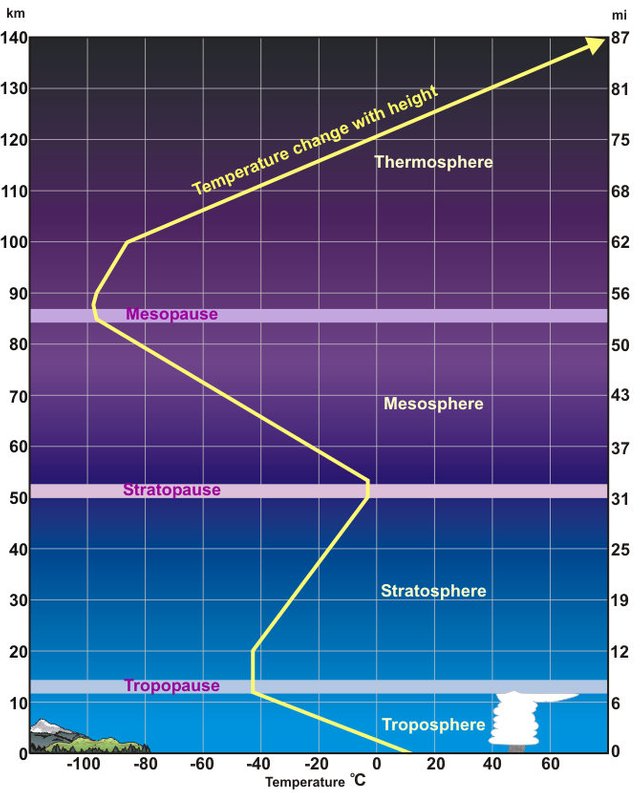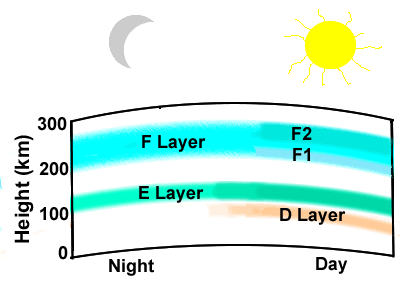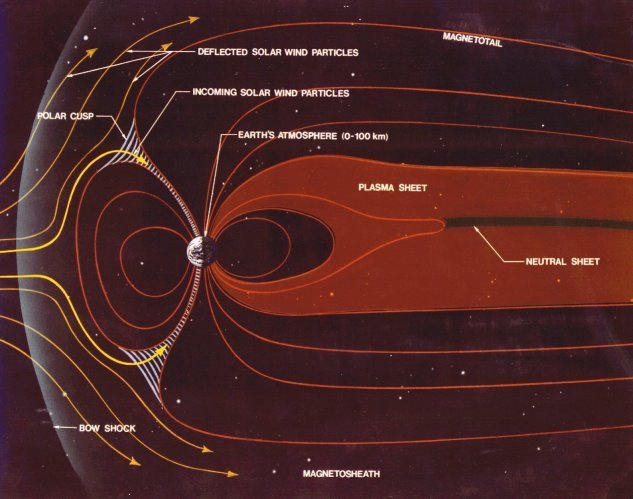Atmospheric Layers and Magneto Electrical Layer.
In this article we will see the various layers of atmosphere. 99% of the gases that are present in the atmosphere are confined to first 32 kilometres. The various layers of atmosphere have their own importance and we will see those layers in detail. Due to the influence of magnetic field and the influence of the solar winds and the solar phenomena there are layers which are above the earth. So, we can classify layers broadly into two types:
- Thermal layers - layers which exist within the Earth.
- Magnetic electrical layers - layers which surround the Earth.
Now, most of the geographers do not consider magneto electrical structure as the part of layers of atmosphere. However, this is still a controversial topic. Whether this should be included as a part of atmosphere or not? Now we will start with the thermal layers and then we'll discuss the magneto electrical layers.
Thermal Layers

See page for author [Public domain], via Wikimedia Commons
So, the first layer of the atmosphere is known as the troposphere. The upper boundary of this layer is known as tropopause so in simple terms I can say wherever word pause is used, it denotes the limit of that layer. So, similarly you have the next layer as a stratosphere and the upper limit would be stratopause and so on. Now, as you can see in above diagram, here I can say troposphere, stratosphere and mesosphere are the layers that are discussed under homosphere. so the classification for the layers would be thermal and magnetic electrical. Thermal layer can be classified in two types.
Thermal layer :
a) homosphere
b) heterosphere
Homosphere means where there is uniform mixing of gases. While, in Heterosphere it is non-uniform mixing of gases. We will cover this in detail where we'll see individual layer. So, in simple terms homosphere includes the lower layers that is troposphere, stratosphere, mesosphere. While the layer of thermosphere comes under heterosphere and there is non-uniform mixing of the gases. Now, let's move on to this diagram to help us understand the various layers. We will be moving from the lowest layer of the thermal structure so the lowest layer of the thermal structure is troposphere.
Troposphere :
The upper boundary of this layer is known as tropopause. In the troposphere, as you can see, temperature decreases with altitude. There is an interesting phenomena that troposphere extends up to eight kilometers towards poles. However, towards equator it extends up to 18 kilometres. Why there is such a difference between pole and equator? The reason here is very simple because as you can see, in troposphere you have the temperature that is decreasing with altitude. So, by the time you reach the tropopause it would be totally cold. So, all the weather phenomena and all the cloud formations or all the weather activities would be occurring only in the region of troposphere which is up to around 10 kilometers of height at the maximum. Now, what happens towards the equator? It has maximum depth because the warm temperature here leads to vertical mixing of the atmospheric layers or I could say the vertical expansion of the lower atmosphere because of higher temperature it leads to vertical expansion of the lower atmosphere and as a result you have the extent of troposphere that varies from equator to pole. Towards equator, you have higher extension of troposphere. Towards poles you have lesser extension of troposphere's the uppermost limit as I said is the tropopause.
Stratosphere :
Stratosphere usually extends from 15 to 50 kilometers or you can say 55 kilometers. The major phenomena here is presence of ozone layer. The harmful ultraviolet rays that comes onto the Earth's surface and Ozone layer protects the Earth from them.Ozone presented here is considered useful for human beings. However if ozone is present in troposphere it is considered as a pollutant. So, ozone (O3), if it occurs in stratosphere it protects human beibgs from the harmful ultraviolet rays. Now, another characteristic feature of stratosphere is there are no clouds. Clouds are found till the layer of troposphere. In the stratosphere, clouds become absent there is movement of air but that is only in the horizontal fashion. So, you have horizontal movement of air that is another characteristic of troposphere. Now, for the first nine kilometers the temperature is somewhat constant. However, after the first nine kilometers temperature increases with altitude in case of stratosphere. The basic reason for this is absorption of the radiation by ozone. Now, it's important that there is increase in the temperature with height both in the stratosphere and thermosphere but the reason for the rise of the temperature in both the cases is totally different. In the stratosphere, the temperature is increases with height because there is absorption of the radiation by the ozone layer. However, in case of thermosphere it is increasing because of the low density molecules that are found in thermosphere. We'll be covering this further. Now, we have seen troposphere. So, in troposphere, as I said before, most of the heat is trapped here .The tropopause of the above layer acts as a barrier and it does not allow the further cold layer to pass beyond. So, most of the heat gets trapped within the troposphere itself which causes the heating of the earth, the melting of the polar ice, the rise of the ocean levels and so on. So, all the weather phenomena and the associated phenomenons occur in the troposphere. The upper limit of the stratosphere is known as stratopause. Beyond the stratopause you have mesosphere.
Mesosphere :
Now, ,esosphere is another interesting layer that extends up to 80 kilometers and most of the shooting stars get burnt up in mesosphere leaving a kind of trail behind. In this mesosphere you have rarefied gas. So, gases occur in rarefied fashion in mesosphere and in all the three layers, the mesosphere, stratosphere and troposphere you have uniform mixing of the layers and therefore they are knowns as homosphere. So, these three layers are part of homosphere. And mesosphere, as you can see there is decrease in the temperature with height. The uppermost layer is known as mesopause. It is the coldest layer. So, at the mesopause you have the coldest temperature around minus 80 degree celcius. Now we move on to the next important layer that is thermosphere.
Thermosphere :
Now, the thermosphere extends from 80 kilometers to the outer space. So, if I switch onto the previous thermosphere occurs as a part of heterosphere. So, you have a kind of non-uniform mixing of the gases here. The lower most layers are higher in molecular mass as compared to the upper layers. So, you have nitrogen, oxygen, helium and hydrogen in an order. And this layer is highly stratified because of the variation in the gases as you can see the temperature increases with height the reason we already explained is due to the low density molecules that occur in this layer. So, you have increase in the temperature with height it extends from 80 kilometers till outer atmosphere. The most important thing is the temperature is maximum here and it can reach up to 1200 degree Celsius. Most of the International Space Stations get established in the thermosphere itself. It is a major reason for establishment of international space centers. Then you have the exosphere, the base of which lower layer is known as exobase. It is important to note that pause is the outermost layer while base is the layer from which the exosphere starts. So, the layer from where the exosphere starts is known as Exobase. It's the lower most layer as we have seen the gases become rarefied in mesosphere and they usually kind of vanish beyond thermosphere and by exosphere it's in a highly rarefied form. You can say helium is the most commonly found gas in the exosphere. It ranges from 400 kilometers till thousand kilometres. Exosphere and ionosphere are not independently defined. They are considered as part of thermosphere. So, the outer layers of thermosphere are considered as exosphere. Most of the gases here found either in helium form or hydrogen form are highly rarefied. Mainly the form of nebula hydrogen ions are formed here and the outermost limit of the exosphere. You have a temperature around 5500 degree Celsius. After that comes ionosphere. Ionosphere is a layer of ions. There is no starting point that you can say but however it is considered that ionosphere starts from mesosphere. So, you have ionosphere that it starts from around 62 thousand kilometers. So it starts from mesosphere itself. The air is again in the rarefied form as you can see the temperature increases with height for most of the layers. Now, ionosphere occurs in four basic layers.
- d
- e
- f and
- g

Image By Naval Postgraduate School [Public domain], via Wikimedia Commons
g is considered as the outermost layer. It's rarely discussed. The most common layers are d, e and f layers that we will see here. So this diagram shows the layers of ionosphere. You have d, e, f1 and f2. Diagram is divided in day and night. d layer is totally absent in the night sky so d layers can be seen only during the daytime. The basic characteristic of d layer is it absorbs extreme hard x-rays e layer absorbs soft x-rays and f layer absorbs extreme ultraviolet radiations. So, these are the main function of these layers. As you can see d is totally absent in the night sky. It's found in the lower most layers from around 75 to 90 kilometers. e layer is the next layer from 100 to 120 kilometers. Now, e layer is partially seen in the night sky. e layer can be again of 2 types, Es and E2. Es is the sporadic layer and this sporadic layer is a kind of small layer that is mainly result of ionization and it kind of supports the reflection of radio waves. So, it's important for the purpose of radio waves. The next layer within the e layer is the E2 layer it appears on the ionogram at around 150 kilometres. The next layer is the F layer. Now f layer could be further classified as f1 and f2 layers. f1 layer that occurs in the night-time and the other layer that disappears. Or deformations that occur in the night sky for the f1 layer. However f2 layer occurs during the night sky as well. f2 layer is the layer which is used for propagation of radio waves at highest frequency within this layer. So, you have the importance of f2 layer because of the propagation of the high frequency radio waves which can help you in distance communication. So, these are some of the layers of ionosphere.
Now, some of the researchers believe that ionosphere is a kind of controversial layer. Most of them believe that ionosphere is considered as part of the thermal structure or the layers within earth however some of them explain that ionosphere could exist beyond the surface of earth as well. So, it's still under controversy where to include ionosphere?
A good recap of what we have covered for the thermal layers :

Image By NOAA & User:Mysid [Public domain], via Wikimedia Commons
You have troposphere. You have hot air balloons within the troposphere. The outer boundary of the troposphere would be apt for flying of helicopters. You can find Auroras, you can find space shuttles and you can find space orbits that are established in thermosphere. In the mesosphere, you have most of the shooting stars that end up burned there.
Magneto electrical structure :
Magneto electrical structure is considered beyond the the region of Earth. Now what is the Sun radiating is the solar winds and earth has its own geomagnetic field. Now, most of the scholars consider that the effect of magnetosphere occurs beyond the ionosphere. However, earth's magnetic field occurs everywhere. It's only beyond the ionosphere that it is strongly or predominantly faded or you can see the influence of magnetosphere is predominant only after the region of ionosphere. In the magneto electrical structure, we consider the inner one as plasma sphere and the outer
one as magnetosphere. We will see both of these one by one.
The region where the solar winds interact with the Earth's magnetic field is known as the outermost limit of magnetosphere, the magnetopause. Now, what happens actually is the solar winds that come in magnetic field of the earth and in the region of bow shock and magnetosheath, the solar winds get heated up and because of this they kind of change their path and that occurs in the region of Bow Shock and the region of magnetosheath. That's outermost boundary you can see in above diagram. However, within magnetopause we have few basic things, one of those is known as the plasmasphere. Then we have the radiation bands. These radiation bands are important for the technological establishment. The technical phenomena that could be seen under the influence of radiation bands in this region.
So now,, outside the earth we have the plasmasphere. Now, what is plasma sphere made of? plasma sphere is made of the fourth state of matter and that state of matter is known as plasma. It's mainly in the form of hydrogen, ions, protons and electrons. The outermost boundary of the plasmasphere is known as plasmapause as I explained previously. And inside the plasmapause you have the geomagnetic field lines which rotate within the earth and beyond that the core rotate. So, we have the earth then we have the influence of plasma then plasmasphere where you have the Fourth state of the matter as plasma. We don't have gases in this layer. It's mainly in the form of hydrogen, ions, protons and oxygen. So, plasmasphere is sometimes considered as an extension of ionosphere and it is a structure that lies within the magnetosphere. Now, moving on to magnetosphere it is important to note that we have a tail formation that is towards the opposite side of the Sun. So, on the one side of the day would have day and the other side would have night and the region where you will have night you will have the presence of magneto tails. So, I can say magneto tail is seen only during the night sky you cannot see a magneto tail during the day sky.So, magneto tail is seen opposite to the Sun and you have the northern lobe and the southern lobe. You have the northern magnetic tail and the southern magnetic tail that occurs here. So, in magnetosphere, what happening is magnetic field lines are unable to co-rotate as they are strongly influenced by the geomagnetic field of the earth. It is also constrained by the solar winds. That is another thing that you need to know.
References :
- https://www.nasa.gov/mission_pages/sunearth/science/magnetosphere2.html
- https://en.wikipedia.org/wiki/Troposphere
- https://en.wikipedia.org/wiki/Stratosphere
- https://en.wikipedia.org/wiki/Mesosphere
- https://en.wikipedia.org/wiki/Thermosphere
- https://en.wikipedia.org/wiki/Ionosphere
- https://en.wikipedia.org/wiki/Magnetosheath
- https://en.wikipedia.org/wiki/Magnetosphere
If you liked this article please upvote and resteem. Follow @pratique007
Thank you

You received a 80.0% upvote since you are a member of geopolis and wrote in the category of "geopolis".
To read more about us and what we do, click here.
https://steemit.com/geopolis/@geopolis/geopolis-the-community-for-global-sciences-update-4
Congratulations! This post has been upvoted from the communal account, @minnowsupport, by pratique007 from the Minnow Support Project. It's a witness project run by aggroed, ausbitbank, teamsteem, theprophet0, someguy123, neoxian, followbtcnews, and netuoso. The goal is to help Steemit grow by supporting Minnows. Please find us at the Peace, Abundance, and Liberty Network (PALnet) Discord Channel. It's a completely public and open space to all members of the Steemit community who voluntarily choose to be there.
If you would like to delegate to the Minnow Support Project you can do so by clicking on the following links: 50SP, 100SP, 250SP, 500SP, 1000SP, 5000SP.
Be sure to leave at least 50SP undelegated on your account.